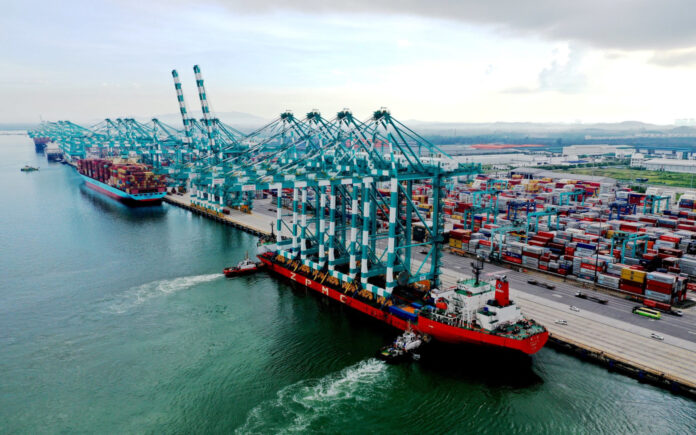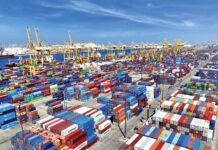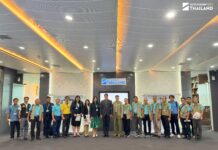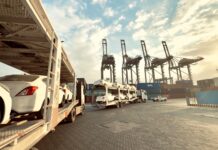
The Malaysian Port of Tanjung Pelepas (PTP), a joint venture between APM Terminals (30%) and the MMC Group, has been selected to join the Partnerships for Infrastructure (P4I) initiative. This government-to-government decarbonisation scheme between Malaysia and Australia supports PTP’s ambition to become a green bunkering hub for alternative fuels.
The P4I project aims to spearhead Malaysia’s decarbonising effort in the maritime industry and to foster inclusive growth through sustainable infrastructure in Southeast Asia.
Malaysia has the potential to develop into a regional green fuel bunkering hub with the support of both industry and government, according to a study by the Australian Government’s Partnership for Infrastructure (P4I). The study also found that methanol is the green fuel option receiving the most investment from shipping lines.
Green Refuelling Sites
The study was undertaken in response to a request from Malaysia’s Transport Ministry (MoT) to better understand zero-carbon bunkering and explore the potential for green refuelling sites in Malaysia.
“We hope that the successful implementation of this initiative will become a game changer in transforming the regional maritime industry and further promote opportunities for Malaysia to lead in maritime decarbonisation,” said PTP Chief Executive Officer Marco Neelsen.
“Given the size and strategic location of PTP, it has the potential to play a key role regionally and globally in supporting maritime and trade decarbonisation,” commented Executive General Manager Commercial at Port of Melbourne, Shaun Mooney.
Lofty Ambitions
Shipping accounts for nearly 3 per cent of global emissions, with the International Maritime Organization setting a goal to halve annual emissions by 2050 and establish green shipping corridors for vessels using zero-emission fuel.
In support of this, for APM Terminals fully controlled Ports and Container Terminals, the company has made an industry-leading commitment to reduce its total emissions by 70% by 2030 compared to 2020 and be fully net zero by 2040.
PTP’s decarbonisation goal is to reduce 45% of its emissions by 2030, having already shaved 30% off its carbon emissions by 2021 compared with its 2011 baseline.
Over the next five years, says Neelsen, PTP will be spending RM3 billion to step up efforts to upgrade its current terminal footprint, including automation, digitalisation and other port functions.
Electrification – Reduced Emissions – Increased Efficiency
According to the company, PTP has electrified and digitalised many of its assets, resulting in reductions in emissions, increased efficiency and less waste. For instance, it will electrify all its rubber-treated gantry (RTG) cranes — mobile cranes that stack and transport containers — and yard by the end of this year. The port is also testing electric prime movers, which are the trucks that move containers, and electric or hybrid fuel tugs and pilot boats.
PTP’s digital transformation also involves tracking its assets and using digital twins. Functioning as computer-based models, digital twins offer real-time visualisations of the port’s operations, infrastructure and assets to, for example, calculate optimal routes for its trucks and boats to save on fuel.
“Digitalisation, operational efficiency and sustainability are all moving as one transformation activity. It’s something that we can see having a positive impact. We do the transformation together rather than working on your own,” says Khairul Amalin Abd Rahman, Senior General Manager at PTP.
Technology Push
One of the technologies used at PTP is the vessel traffic management system. The VTMS is connected to the Marine Resource Management System (MRMS) and Vessel Traffic Monitoring and Information System (VTMIS) — both of which are used to step up measures to become a “green” port. It improves the efficiency of vessel traffic movements and the safety of navigation.
The MRMS can integrate the entire process, from booking a berth to populating shipping registers, ordering pilots and providing vessel arrivals and departures. In 2022, PTP handled 10,608 vessel calls.
All this costs money. But Neelsen believes it makes business sense. Rising fuel prices and carbon taxes will be costly to those who do not transition. “There will be an extra cost in the future, so we need to start incorporating it,” he says.
“Our customers, which are the shipping lines, forwarders, warehouses and their customers, have different demands than they had ten years ago. Therefore, this is part of our transformation journey. It has been requested by customers whose children are asking questions [about how sustainable their products are]. The logistics [industry] has to adapt to it,” concludes Marco Neelsen, CEO of PTP.
อัพเดตข่าวสารและบทความที่น่าสนใจในอุตสาหกรรมโลจิสติกส์ก่อนใคร ผ่าน Line Official Account @Logistics Mananger เพียงเพิ่มเราเป็นเพื่อน @Logistics Manager หรือคลิกที่นี่














